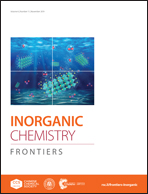Fabrication of a Z-scheme AgBr/Bi4O5Br2 nanocomposite and its high efficiency in photocatalytic N2 fixation and dye degradation†
Abstract
A AgBr/Bi4O5Br2 nanocomposite (actually a Ag/AgBr/Bi4O5Br2 ternary system) was synthesized by a combination of hydrothermal and ion exchange procedures and applied for the first time in photocatalytic nitrogen fixation. The detailed characterizations indicated that only a small amount of AgBr was formed on the surface of the Bi4O5Br2 nanosheets. Hence, the morphology, BET surface area, and pore size distribution of Bi4O5Br2 changed slightly. However, the charge separation efficiency significantly increased, which was realized via the oriented electron migration between AgBr and Bi4O5Br2 in a Z-scheme mechanism. The Ag nanoparticles formed in situ via the decomposition of AgBr act as the bridge of charge migration. Although improved photoabsorption was also observed, the elevated charge separation was believed to be the dominant factor affecting the photocatalytic performance. Therefore, AgBr/Bi4O5Br2 presented outstanding photocatalytic performance. Under simulated sunlight, the optimal 5.0 wt% AgBr/Bi4O5Br2 composite exhibits a NH3 production velocity of 179.4 μmol L−1 g−1 h−1, which is three times that of Bi4O5Br2. For methylene blue degradation, the degradation rate under visible light is 0.097 min−1, which is 3.0 and 12 times faster than those of Bi4O5Br2 and AgBr, respectively. This work may provide useful information for the design and synthesis of efficacious catalysts for photocatalytic N2 fixation.



 Please wait while we load your content...
Please wait while we load your content...